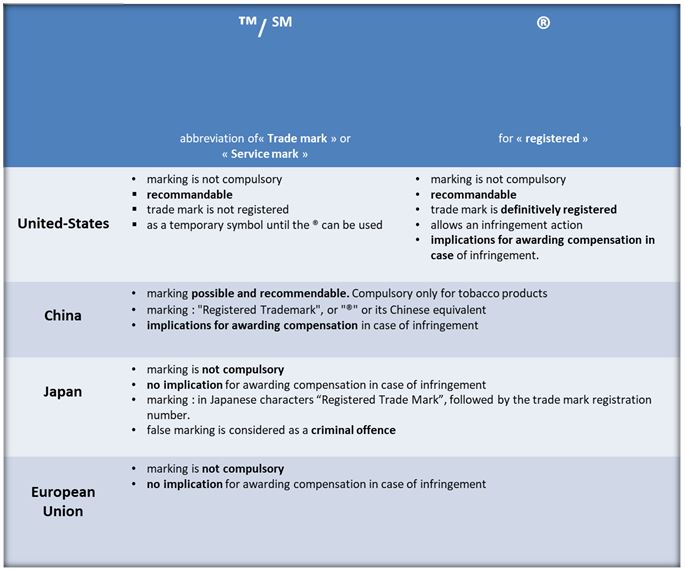2021/06 > Product marking, where do we stand?
The symbols ® ™ © or mentions such as “Trade mark”, “Registered design” are often used in business life, affixed to a logo, attached to a slogan, mentioned on a product or inserted in a graphic charter.
There is no text in French law that provides for or regulates the use of these symbols or terms, which are well known to everyone. Article 5 of the Paris Convention for the Protection of Industrial Property even provides that ” no indication or mention of the patent, of the utility model, of the registration of the trademark, or of the deposit of the industrial design, shall be required upon the goods as a condition of recognition of the right to protection ».
These symbols, of Anglo-American origin (1), are therefore of no legal value in France.
The recognition of an intellectual or industrial property right does not in any way result from the apposition of one of these symbols or mentions.
When affixed to the sign, they therefore have only an informative value in France. It is even recommended to use them only with caution. Adding these symbols to signs that have never been or that are not yet registered may, indeed, be considered as deceptive, and may characterise unfair competition and thus be condemned by the courts.
In a decision of 15 April 2021 (DC 20-0039) dealing with an application for revocation for non-use, the French National Institute of Industrial Property (INPI) nevertheless introduced a few nuances to this classic position, with regard to trade marks.
In this case, the revocation of the trade mark « L’ANE EN CULOTTE » was pursued for lack of valid use, the plaintiff in the case arguing that « the word element « L’ANE EN CULOTTE » has never been used as a trade mark but only to describe a product or service related to a donkey in underpants »
The INPI replies that « the applicant cannot argue that the sign « L’ANE EN CULOTTE » « will not be perceived by the consumer as a trade mark » for certain products. Indeed, not only is this sign affixed to the label of these products, but it is also followed by the ® symbol. Even though this symbol has no legal value in France, it is easily understood by the French public as an indication that the sign is protected as a trade mark and thereby identifies the commercial origin of the products on which it is affixed ».
Thus, the affixing of this symbol or the mention “registered trade mark”, beyond the information it provides, is nowadays of direct use in France in that it facilitates the proof of the use of a sign as a trade mark. It is therefore recommended to indicate them on any document or medium reproducing the registered trade mark.
And what about abroad?
 The symbol © which means Copyright follows the same logic as the symbols ® and ™
The symbol © which means Copyright follows the same logic as the symbols ® and ™
It is part of the system of protection of literary and artistic works in certain countries, notably the U.S.A., a system that differs from the one used in French law since it requires a registration of the work in a Copyright register
Its use does not have any legal standing in France and is only recommended in common law countries. The same applies to the terms « Patented », « Breveté » or « Registered Design ».
One should recall that, once again, the use of such a mention in a false manner may be sanctioned. Thus, the Paris Court of Appeal in its decision of 11 June 2019 (2) has once more ruled that the fact of improperly claiming a patent status was likely to constitute a criminal offence. In addition, the Court decided that « marketing light fittings with electrical connection boxes very similar in shape to those manufactured and marketed by MOULAGES PLASTIQUES DU MIDI and bearing expressions (‘PATENTED’, ‘VDE’) suggesting that these boxes, like those of the appellant, are patented or certified », or even that they are products of this other company, « was likely to bring about a risk of confusion as to the origin of the products in question for consumers or professionals installing the light fittings in customers’ homes » and constituted acts of unfair competition.
So although these terms are useful, as the INPI decision shows, their use must remain within a framework of truth and moderation.
(1) The TM symbol was first introduced in the United States in the Trademark Act of 1946
(2) Paris Court of Appeal, Pole 5 – Ch. 1, 11 June 2019, n° 17/04525